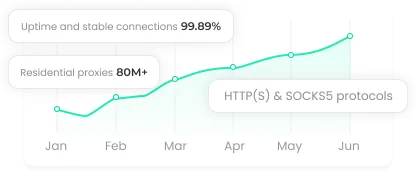Scraping LinkedIn: Tools, Tips, and Rules You Can’t Ignore
Data beats intuition every time, and on LinkedIn, that is especially true. For HR teams, sales professionals, and marketers, the platform holds a wealth of insights if you know how to access them. With millions of profiles, manually collecting information is slow and exhausting. Scraping offers a way to save time, scale your efforts, and obtain the data you need in a legal and strategic manner. But beware. LinkedIn isn’t just a database; it’s a fortress. Scraping comes with serious hurdles.

Why LinkedIn Scraping Is Tricky
LinkedIn is committed to user protection. This comes with strict rules, anti-bot measures, and constant updates. Some of the challenges you'll face include:
Rate limits: Too many requests? You're temporarily blocked.
Anti-bot measures: CAPTCHAs, login challenges, and hidden checks.
Complex data structures: It's not always straightforward to parse information.
Legal and account risks: Violating Terms of Service could mean permanent bans.
Even if your method worked yesterday, LinkedIn can change its algorithms overnight. A scraping tactic that's foolproof today might fail tomorrow. You need to stay alert, test constantly, and adjust strategies.
LinkedIn Scraping Tips
Scraping is a gray zone. Here's how to do it responsibly and effectively:
Review LinkedIn's Terms of Service regularly: They change, and you need to adapt to avoid penalties.
Respect data privacy laws like GDPR and CCPA: Always handle data ethically—never sell it or misuse it.
Stick to public data: Company names, job titles, and emails. Private info is off-limits.
Watch engagement metrics: Sudden drops can signal that LinkedIn flags your activity as suspicious.
Pause if flagged: Temporary bans are LinkedIn's way of saying “slow down.” Step back, reassess, and adjust.
Multiple accounts? That's risky. LinkedIn frowns on it. Only consider this with full awareness of the rules.
Tools That Make Scraping Effective
The key to success? Make every action look human. Randomize timing. Mix interactions. Avoid predictable patterns. The right tool can save you headaches.
Octoparse: No-code drag-and-drop interface. Cloud-based, so scraping continues even when your computer is off. Perfect for non-tech teams.
Scrapy: Python-based and highly customizable. Ideal for developers handling large-scale projects. Free and flexible.
SalesQL: Focused on leads. Extracts emails and phone numbers directly to your CRM with a simple Chrome extension.
Apify: Cloud-based, scalable, and LinkedIn-optimized. Use pre-built templates or custom scripts for larger businesses.
LinkedIn Helper 2: Automates not only scraping but engagement too. Paid, with a 14-day trial.
Supplementary Tools for Human-Like Scraping
To stay under LinkedIn's radar, combine scraping tools with:
Anti-detect browsers: Separate profiles, unique cookies, and IPs make detection harder.
VPNs: Mask geolocation, add a security layer, and avoid bans. Affordable options like ZoogVPN are reliable.
Headless browsers: Process large volumes quickly while conserving system resources.
Session management tools: Mimic continuous human browsing instead of suspicious one-off grabs.
Proxies: Residential and mobile proxies hide your IP and distribute requests. Free proxies? Skip them—they're red flags.
The Bottom Line
LinkedIn scraping isn't just a tech challenge—it's a strategy game. Done right, it's a time-saver and a goldmine for insights. Done wrong, it's a risk for your accounts and reputation. Combine smart tools, ethical practices, and constant adaptation, and you'll turn LinkedIn's data into actionable intelligence without stepping on the wrong toes.

















































